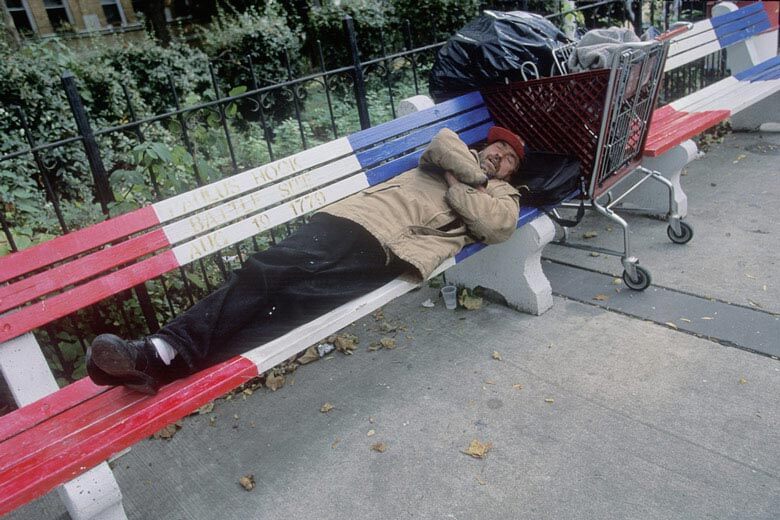The United States is dead last on many poverty and inequality outcomes when compared with other well-to-do countries, according to a new report by the Stanford Center on Poverty and Inequality.
This year’s report, issued today, examines how the U.S. is faring relative to other well-off countries. Written by some of the world’s leading experts on poverty and inequality, the report includes data on poverty, employment, income and wealth inequality, economic mobility, educational outcomes, health inequality and residential segregation.
The research shows that, among the well-off countries for which comprehensive evidence is available, the U.S. has the lowest overall ranking, a result that arises in part because the U.S. brings up the rear in safety net performance, income inequality and wealth inequality. When the comparison set is expanded to include other less well-off countries, America still ranks 18th (out of 21 countries), with only Spain, Estonia and Greece scoring worse.
More than two dozen countries were studied overall, along with the United States. Not all were ranked in each category. Among the countries included are Australia, the United Kingdom, Italy, Germany, France, Norway and Canada.
David Grusky, the center’s director, said that “we’ve long known that the U.S. is exceptional, but it hasn’t been fully appreciated that it’s such a standout in so many types of inequality.”
The report also shows that the U.S. performs poorly in many areas that have historically been regarded as its strengths:
• The U.S. is not a jobs machine: Although it is often argued that the U.S. is a “jobs machine,” in fact it ranks eighth out of 10 in prime-age employment among women (with only Italy and Spain faring worse) and ninth out of 10 in prime-age employment among men (with only Spain faring worse).
• The U.S. is not delivering on its commitment to economic mobility: The U.S., long understood as the “land of opportunity,” ranks eighth out of 10 countries in the level of economic mobility.
• The U.S. is not a land of health equality: In some states like Alabama and Kentucky, levels of average health and health inequality compare with post-Soviet-bloc countries like Bulgaria, Estonia and Latvia.
A silver lining
The report also notes some bright spots. It shows, for example, that a relatively moderate increase in U.S. safety net spending would push the poverty rate down to levels observed in other well-off countries. The rate of disposable-income poverty, which is the rate that people actually experience after transfers play out, is especially high not because market incomes are all that low but because the safety net is relatively small.
“This is good news,” Grusky said, “because in principle it is easier to reform the safety net than to attempt to retool the economy in ways that would deliver higher market incomes.”
Grusky, the Barbara Kimball Browning Professor in the School of Humanities and Sciences, suggested that if the U.S. safety net were ramped up to the standard of other liberal economies (especially the United Kingdom), much headway would be made in reducing poverty.
A “safety net” is a collection of services provided by the state – or even other institutions – such as welfare, unemployment benefits, health care, homeless shelters and subsidized services such as public transport. The idea is to prevent individuals from falling into poverty beyond a certain level.
Reasons for rankings
Why does the U.S rank so high on so many different types of inequality? Though there are many reasons why “all bad things” come together, Grusky suggested that “feedback loops” may be partly responsible.
For example, residential segregation has the effect of protecting well-off children from educational competition and increasing their earnings, which then triggers a further rise in income inequality and a further increase in residential segregation. This is known as a feedback loop, according to Grusky.
These types of feedback loops are, Grusky noted, worrying because they “suggest a dynamic system that has run amok.” According to the poverty center’s research, offering underprivileged children more and better opportunities for high-quality education, including at the college level, would help lessen the poverty and inequality gap.
It is possible, Grusky suggested, to stop those forces by “intervening in a feedback loop and turning it against itself.”
In 2013, the Stanford Center on Poverty and Inequality produced its first annual report card, evaluating how well the country is addressing poverty, inequality and opportunity.
If our reporting has informed or inspired you, please consider making a donation. Every contribution, no matter the size, empowers us to continue delivering accurate, engaging, and trustworthy science and medical news. Independent journalism requires time, effort, and resources—your support ensures we can keep uncovering the stories that matter most to you.
Join us in making knowledge accessible and impactful. Thank you for standing with us!

